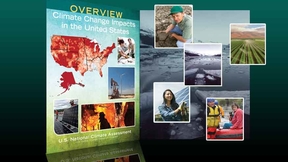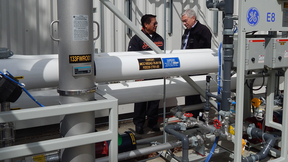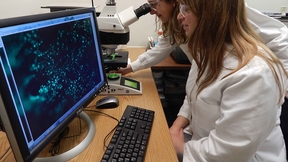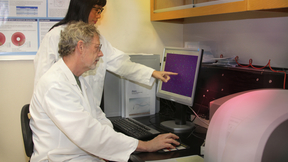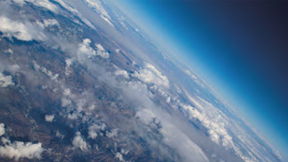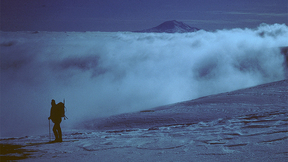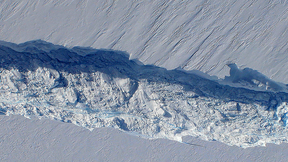Back
Livermore students virtually got up close and personal with Lawrence Livermore scientists and Livermore Mayor John Marchand on the anniversary of Livermorium Day. Established in 2013, Marchand decreed May 30 as Livermorium Day to recognize the naming of element 116, which was named after the City Livermore and Lawrence Livermore National Laboratory. During a Google Hangout…
New research by an international consortium, including a researcher from Lawrence Livermore National Laboratory, may help physicians better understand the chronological development of a brain aneurysm.Using radiocarbon dating to date samples of ruptured and unruptured cerebral aneurysm (CA) tissue, the team, led by neurosurgeon Nima Etminan, found that the main structural…
LIVERMORE, Calif. --Lawrence Livermore National Laboratory (LLNL), the City of Livermore and the Livermore Valley Joint Unified School District will be hosting a day of events, both online and downtown, to celebrate the first anniversary of Livermorium Day on Friday, May 30.Livermore Mayor John Marchand proclaimed May 30 Livermorium Day to recognize the discovery of…
Using one of the world's largest telescopes, a Lawrence Livermore team and international collaborators have tracked the orbit of a planet at least four times the size of Jupiter.The scientists were able to identify the orbit of the exoplanet, Beta Pictoris b, which sits 63 light years from our solar system, by using the Gemini Planet Imager's (GPI) next-generation, high…
California will experience increased heat, drought and insect outbreaks and more wildfires, according to a new report released Tuesday by the White House.The National Climate Assessment reportalso explains how California will have to deal with declining water supplies, reduced agricultural yields, health impacts in cities due to heat and flooding and erosion in coastal…
Last week, three teams of Lawrence Livermore employees were recognized for their efforts in implementing sustainability projects at the Laboratory. These projects received 2013 Sustainability Awards from the National Nuclear Security Administration (NNSA).The awards recognize exemplary individual and team performance in advancing sustainability objectives through…
Element 117, first discovered by Lawrence Livermor escientists and international collaborators in 2010, is one step closer to being named.The existence of element 117 and its decay chain to elements 115 and 113 have been confirmed by a second international team led by scientists at GSI Helmholtz Centre for Heavy Ion Research, an accelerator laboratory located in Darmstadt,…
Using an ultrafast laser system, a group in Physical and Life Sciences at Lawrence Livermore National Laboratory have subjected iron to extremely rapid dynamic compression and have shown that the transition from one crystal structure to another can take place in less than 100 trillionths of a second after the compression begins.If a material is squeezed hard enough, the…
At one point in history, Greenland was actually green and not a country covered in ice.An international team of researchers, including a former scientist from Lawrence Livermore National Laboratory, has discovered that ancient dirt in Greenland was cryogenically frozen for millions of years under nearly two miles of ice.More than 2.5 million years ago. Greenland looked…
Livermore microbiologist Yongqin Jiao is midway through a five-year study to investigate how certain aerobic bacteria interact with uranium in aquatic environments.
Mark Zelinka has his head in the clouds.The researcher in the Program for Climate Model Diagnosis and Intercomparison is delving into research on how climate change affects cloud properties and vice versa.Using detailed data from satellites and climate models, Zelinka, who was recently converted from a postdoc to staff scientist, examines the vertical structure and optical…
The Laboratory has launched a pilot project to reduce potable water use by using treated groundwater to cool equipment and research facilities at the main site.Water from one of LLNL's treatment wells is being run through a reverse osmosis filtration unit and used as an alternative to the Hetch-Hetchy water used in the Bldg. 133 cooling tower on the west side of the Lab…
Lawrence Livermore scientists have found that carbon nanotubes can help with tissue healing and repair.The team, which includes scientists from The Feinstein Institute for Medical Research, UC Davis and UC Merced, found that there is long-term biocompatibility of single wall carbon nanotubes (SWNTs) when used for tissue engineering and articular cartilage.Carbon nanotubes…
Lawrence Livermore scientists have modeled actinide-based alloys, such as spent nuclear fuel, in an effort to predict the impact of evolving fuel chemistry on material performance. This work, funded by a Laboratory Directed Research and Development Program on "Scientific Basis for Ultra-high Burn-up Nuclear Fuels," could have direct implications for the use of spent…
Using the VUV Free-Electron Laser (FEL) FLASH at Deutsches Elektronen-Synchrotron (DESY) in Hamburg, Germany, Lawrence Livermore researchers were part of a team that took a sneak peek deep into the lower atmospheric layers of giant gas planets such as Jupiter or Saturn. Their observations reveal how liquid hydrogen becomes a plasma and provide information on the material's…
It was 100 years ago that the use of X-rays to determine the crystal structure of materials emerged. The pioneering work of Max von Laue, for which he was awarded the Nobel Prize in physics, was followed by a joint award, also in physics, the next year (1915) to the father and son team of William and Lawrence Bragg. Since then, more than 25 Nobel Prizes have been awarded…
Scientists who study past pandemics, such as the 14th century Black Death that devastated much of Europe, might soon be turning to an innovative biological detection technology for some extra help.The apparent first use of this technology, known as a microarray, for studying pathogens from ancient DNA, was reported today by a team of scientists in the daily online journal,…
If emissions of greenhouse gases continue in a business-as-usual manner, future changes in climate will substantially exceed those that have occurred so far, with a warming of the Earth in the range of roughly 5 to 9 degrees Fahrenheit by the end of the century. That is the conclusion of a new report by the U.S. National Academy of Sciences (NAS) and The Royal Society,…
LIVERMORE, Calif. -- Volcanic eruptions in the early part of the 21st century have cooled the planet, according to a study led by Lawrence Livermore National Laboratory. This cooling partly offset the warming produced by greenhouse gases. Despite continuing increases in atmospheric levels of greenhouse gases, and in the total heat content of the ocean, global-mean…
A study of the Pine Island Glacier could provide insight into the patterns and duration of glacial melt. The Pine Island Glacier, a major outlet of the West Antarctic Ice Sheet, has been undergoing rapid melting and retreating for the past two decades. But new research by an international team including researchers from Lawrence Livermore National Laboratory shows that…





